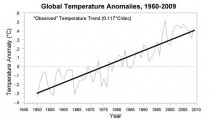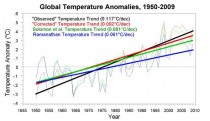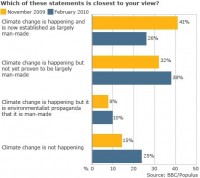NRO Editorial
Exaggeration and alarmism have been a chronic weakness of environmentalism since it became an organized movement in the 1960s. Every ecological problem was instantly transformed into a potential world-ending crisis, from the population bomb to the imminent resource depletion of the “limits to growth: fad of the 1970s to acid rain to ozone depletion, always with an overlay of moral condemnation of anyone who dissented from environmental correctness. With global warming, the environmental movement thought it had hit the jackpot - a crisis sufficiently long-range that it could not be falsified and broad enough to justify massive political controls on resource use at a global level.
Former Colorado senator Tim Wirth was unusually candid when he remarked in the early days of the climate campaign that “we’ve got to ride the global-warming issue. Even if the theory of global warming is wrong, we will be doing the right thing - in terms of economic policy and environmental policy.” (Not surprisingly, after Wirth left the Senate and the Clinton administration he ended up at the United Nations.)
The global-warming thrill ride looks to be coming to an end, undone by the same politically motivated serial exaggeration and moral preening that discredited previous apocalypses. On the heels of the East Anglia University “Climategate” scandal have come a series of embarrassing retractions from the U.N.’s Intergovernmental Panel on Climate Change (IPCC) regarding some of the most loudly trumpeted signs and wonders of global warming, such as the ludicrous claim that Himalayan glaciers would disappear within 30 years, that nearly half of the Amazon jungle was at imminent risk of destruction from a warming planet, and that there was a clear linkage between climate change and weather-related economic losses. The sources for these claims turned out to be environmental advocacy groups - not rigorous, peer-reviewed science.
To be sure, these revelations do not in and of themselves mean that the idea of anthropogenic global warming is false. But this is probably the beginning of a wholesale revision of the conventional wisdom on climate change. One of the central issues of Climategate - the veracity and integrity of the surface-temperature records used for our estimates of warming over the last few decades - is far from resolved. The next frontier is likely to be a fresh debate about basic climate sensitivity itself. There have been several recent peer-reviewed papers suggesting much lower climate sensitivity to greenhouse gases than the IPCC “consensus” computer models predict. And alternative explanations for observed climate change in the Arctic and elsewhere, such as shifts in ocean currents and wind patterns, should receive a second look.
Dissenters who pointed out these and other flaws in the IPCC consensus were demonized as deniers and ignored by the media, but they are now vindicated. (The American media are still averting their gaze, though the British press - even the left-wing Guardian and the Independent - is turning on the climate campaigners with deserved vengeance.) The IPCC is mumbling about non-specific reforms and changes in the process shaping its next massive climate report, due out in three or four years. The IPCC should emulate a typical feature of American government commissions and include a minority report from dissenters or scientists with a different emphasis. But the next IPCC report may not matter much: With the collapse of the Kyoto-Copenhagen process and the likely rejection of cap-and-trade in Congress, climate mania may have run its course.
See editorial here.
-------------------------
EPA Mandates Rely On Unsettled Science
By Shannon L. Goessling, Investors Business Daily
That the Obama administration and the Environmental Protection Agency are on the wrong climate path is the understatement of the decade.
Recent disclosures through ClimateGate, an EPA whistle-blower and a daily barrage of scientific data call into question every assumption of the United Nations’ Intergovernmental Panel on Climate Change (IPCC).
These disclosures make it clear that the EPA’s rush to regulate every aspect of American commerce, energy and consumer choices is based on flawed and perhaps even fraudulent scientific data.
Even according to a number of IPCC scientists, if the entire planet adopted the Kyoto Protocol and additionally ceased all productive activity worldwide tomorrow, the global temperature might be reduced slightly less than 1 degree - in 20 to 50 years, a trivial “benefit” purchased at catastrophic cost.
EPA defenders in Congress say not to worry because the regulations that will flow from the EPA’s December 2009 endangerment finding have yet to be enacted.
Here’s the truth: According to the EPA’s extensive documentation, the forthcoming regulations are already placing enormous burdens on companies, employers, consumers and energy ratepayers. And once the regulations take effect, it gets worse.
For example, the EPA estimates a 20% across-the-board increase in costs for attorneys, regulatory compliance professionals, engineers and the like in order to comply with the new regulations. Guess who’ll pay the tab? You and I.
Representing more than a dozen members of Congress and more than two dozen associations and companies that are dramatically affected by the new EPA endangerment finding, our firm filed a petition for review with the U.S. Court of Appeals for the District of Columbia this week.
In December, we asked the EPA to reconsider its ill-considered finding. In the coming weeks, we are likely to engage in a number of other challenges to attempt to halt this train wreck.
The Obama administration’s agenda, echoing the globalist mantra heard at the recent Copenhagen climate change conference, would force a command-and-control regime onto the struggling U.S. economy that has no parallel in our nation’s history.
Every American would be affected at great cost. Farmers and agriculture, manufacturers, trucking-transportation companies, railroads, energy producers and suppliers, and energy-intensive industries like concrete and glass will face staggering mandates that may dwarf the potential costs of pending health care reform.
The trade-off promised by global warming acolytes is an avalanche of so-called “green jobs.” A pledge made by President Jimmy Carter more than 30 years ago, millions of green jobs have never materialized, despite billion-dollar public expenditures ostensibly designed to encourage them.
Moreover, according to recent econometric studies of congressional cap-and-trade proposals, which are less stringent than the forthcoming EPA mandates, 4 million U.S. jobs would be lost to increased costs and lower productivity by 2030.
The cost of gasoline, electricity and natural gas would increase approximately 150%. The nation’s gross domestic product would be reduced by more than $630 billion. The impact would be particularly painful to the poor and lower-income families.
Our foundation and the group of petitioners we represent are opposed to the government attempt to take control of key aspects of life on the pretext of saving the planet.
The method by which the EPA arrived at its “finding” is procedurally suspect and is based on science that is anything but what Al Gore has described as “settled.”
The unprecedented cost in lives, jobs, services, consumer choices and quality of life inflicted by the EPA’s draconian measures staggers the imagination, provides no significant environmental benefit and is likely unconstitutional. Read editorial here.
Goessling is executive director and chief legal counsel for the Southeastern Legal Foundation, a public interest law firm and policy center now litigating against the Environmental Protection Agency.
------------------------------
Why the EPA is Wrong about Recent Warming
by Chip Knappenberger, MasterResource
Back in December, the EPA announced that it had determined that greenhouse gases released by human activities “threaten the public health and welfare of current and future generations.” This “Endangerment Finding” is the first step toward EPA’s issuing regulations aimed at restricting GHG emissions in the U.S.
Unfortunately for the EPA, a major pillar of support of the Endangerment Finding - that “most” of the “observed warming” since the mid-20th century is from greenhouse gas emissions from human activities - has been shown by recent scientific research in major peer-reviewed scientific journals to be largely in doubt.
Add this result to the list of problems that seems to grow longer with each passing day as more IPCC gaffes are uncovered and Climategate emails are parsed. One has to wonder just how long it will be until the EPA is challenged to reconsider its Endangerment Finding.
The basis for the Engangerment Finding is contained in the EPA’s Technical Support Document for Endangerment and Cause or Contribute Findings for Greenhouse Gases under Section 202(a) of the Clean Air Act (TSD). The TSD does not describe any new, independent research carried out by the EPA (because they did not undertake any), but instead largely summarizes the findings of the Intergovernmental Panel on Climate Change (IPCC).
One of the key statements (from page 2 of the Executive Summary of the EPA’s TSD) is this - a simple mimic the IPCC AR4 finding:
Most of the observed increase in global average temperatures since the mid-20th century is very likely due to the observed increase in anthropogenic GHG [greenhouse gas] concentrations.
As to what the “observed increase in global average temperature since the mid-20th century” has been, I present Figure 1 - the annual HadCRUT3 global temperature record from 1950 to 2009. The trend line has value of 0.117C/decade which amounts to a total temperature increase of 0.702C over the 60 years from 1950.
As I shall show, this statement is no longer tenable.
As to what the “observed increase in global average temperature since the mid-20th century” has been, I present Figure 1 - the annual HadCRUT3 global temperature record from 1950 to 2009. The trend line has value of 0.117C/decade which amounts to a total temperature increase of 0.702C over the 60 years from 1950.


Observed global temperature history, 1950-2009 (black). “Corrected” global temperature history (red line). “Corrected” temperature history with general influence of stratospheric water vapor (according to Solomon et al., 2010) removed (green line). “Corrected” temperature history with general influence of stratospheric water vapor (according to Solomon et al., 2010) removed and the influence of black carbon (according to Ramanathan and Carmichael, 2009) removed (blue line).
The remaining warming - that which possibly could be caused by anthropogenic GHG increases - now stands at about 0.366C - or just 52% of the EPA’s “observed” increase.
Conclusion - The EPA is Wrong
And I have only included the best estimates from Solomon et al. and Ramanathan and Carmichael. In fact, both studies include a range of estimates. Had I used the low end of the ranges, the remaining warming from GHGs would have been quite a bit less than 50% of the “observed” warming. Also, I used a pretty conservative “correction” based on Thompson et al. Others contend that the “correction” should be larger, and in and of itself could invalidate the EPA/IPCC “most likely” description.
And, I didn’t include any warming from things such as urbanization, land-use change, site changes, or other natural variability - which have been by some studies to have a detectable (warming) impact.
So, if we take what the best science gives us, we find that pretty close to half of the warming that is currently indicated by the extant global temperature datasets may be from influences other than anthropogenic greenhouse gas increases - perhaps a bit less, perhaps a bit more.
Heading back to the EPA’s Description of Likelihood Table (above) we find that instead of “very likely,” probably the most apropos descriptor is found a couple of lines down, the one that encompasses a 33 to 66% probability - or “about as likely as not.”
Read the extensive details here.
By Jonah Goldberg, LA Times
I watched the Super Bowl in the chilled air of the GFISZ (that’s Goldberg Family Ice Station Zebra). Here in Washington, we haven’t seen this much snow since at least 1922. The blizzard of 2010 took out our electricity for a day. Digging out from “snowmaggedon” was nothing less than an Augean challenge, though my lower back is, alas, less than Herculean. Meanwhile, snow canceled my daughter’s 7th birthday party Saturday and her school Monday. We’re slated for another foot by Wednesday.
Suffice it to say I’m not panicking about global warming right now.
Perhaps that’s why I was bemused and intrigued by Audi’s Super Bowl ad.
Audi’s “Green Police” (available on YouTube) depicts an America where citizens are arrested—roughly—for even minor environmental infractions. A man at the supermarket asks for a plastic shopping bag and has his head slammed against the counter as he’s cuffed by a Green Police officer. “You picked the wrong day to mess with the ecosystem, plastic boy,” quips the cop. When officers find a battery in the wrong suburban garbage bin, one big cop yells, “Battery! Let’s go! Take the house!”
It’s a fascinating commercial. They even got Cheap Trick to rerecord “Dream Police” as “Green Police” for the soundtrack. But just as the satire becomes enjoyable, the message changes. Until the pitch for Audi intrudes, you’d think it was a fun parody from a right-wing free-market outfit about the pending dystopian environmental police state.
The pitch involves an “eco roadblock.” A young man driving an Audi A3 TDI is singled out by an inspector. “We’ve got a TDI here,” he says. “Clean diesel,” he adds approvingly.
“You’re good to go, sir,” the cops inform the driver. The smiling Audi owner accelerates to happiness on the open road. The screen fades to black and the tagline appears—“Green has never felt so right.”
So, instead of some healthy don’t-tread-on-me mockery, the moral of the story is that we should welcome our new green overlords and, if we know what’s good for us, surrender to the New Green Order.
Some eco-bloggers disliked the ad because it reinforces the association of undemocratic statism or PC bullying with environmentalism. Perhaps that’s why the New York Times dubbed it “misguided.”
Meanwhile, some conservatives didn’t like it because it makes light of what they believe is actually happening. After all, in America and Europe, the list of environmental crimes is growing at an almost exponential rate. The ad is absurd, of course, but not nearly as absurd as Audi thinks.
What was Audi’s intent? Presumably, to sell cars.
“The ad only makes sense if it’s aimed at people who acknowledge the moral authority of the green police,” writes Grist magazine’s David Roberts on the Huffington Post. The target audience, according to Roberts, are men who want to “do the right thing.” He’s certainly right that the ad isn’t aimed at people (whom he childishly mocks as “teabaggers") who worry that their liberties are being slowly eroded.
But the message is hardly “do the right thing.”
To me, the target demographic is a certain subset of spineless upscale white men (all of the perps in the ad are affluent white guys) who just want to go with the flow. In that sense, the Audi ad has a lot in common with those execrable MasterCard commercials. Targeting the same demographic, those ads depicted hapless fathers being harangued by their children to get with the environmental program. MasterCard’s tagline: “Helping Dad become a better man: Priceless.”
The difference is that MasterCard’s ads were earnest, creepy, diabetes-inducing treacle. Audi’s ad not only fails to invest the greens with moral authority, it concedes that the carbon cops are out of control, unjustly bullying people and power-hungry (in a postscript scene, the Green Police pull over real cops for using Styrofoam cups). But, because resistance is futile when it comes to the eco-borg, you might as well get the best car you can.
It will be interesting to see whether the ad actually sells cars. The premise only works if you take it as a given that this Gorewellian nightmare is inevitable. But the commercials arrive at precisely the moment when that inevitability is unraveling like an old pair of hemp socks. The global warming industry is imploding from scientific scandals, inconvenient weather, economic anxiety and surging popular skepticism (according to a Pew Research Center survey released in January, global warming ranks 21st out of 21 in terms of the public’s priorities).
Personally, this week, I don’t want a car to get past the Green Gestapo. I’m looking for something that can power through the frozen tundra separating me from the supermarket.
Update: See here how the snowblitz has delayed announcement of the new climate agency
By Randolph E. Schmid, AP Science Writer
The Obama administration on Monday proposed a new agency to study and report on the changing climate.
Also known as global warming, climate change has drawn widespread concern in recent years as temperatures around the world rise, threatening to harm crops, spread disease, increase sea levels, change storm and drought patterns and cause polar melting.
Commerce Secretary Gary Locke and Jane Lubchenco, head of the National Oceanic and Atmospheric Administration, announced NOAA will set up the new Climate Service to operate in tandem with NOAA’s National Weather Service and National Ocean Service.
“Whether we like it or not, climate change represents a real threat,” Locke said Monday at a news conference.
Lubchenco added, “Climate change is real, it’s happening now.” She said climate information is vital to the wind power industry, coastal community planning, fishermen and fishery managers, farmers and public health officials.
NOAA recently reported that the decade of 2000-2009 was the warmest on record worldwide; the previous warmest decade was the 1990s. Most atmospheric scientists believe that warming is largely due to human actions, adding gases to the atmosphere by burning fossil fuels such as coal and natural gas.
Researchers and leaders from around the world met last month in Denmark to discuss ways to reduce climate-warming emissions, and a follow-up session is planned for later this year in Mexico.
“More and more people are asking for more and more information about climate and how it’s going to affect them,” Lubchenco explained. So officials decided to combine climate operations into a single unit.
Portions of the Weather Service that have been studying climate, as well as offices from some other NOAA agencies, will be transferred to the new NOAA Climate Service.

The new agency will initially be led by Thomas Karl, director of the current National Climatic Data Center. The Climate Service will be headquartered in Washington and will have six regional directors across the country. Read more here. See the NOAA Climate web site paid for by your dollars (the administration’s fiscal 2011 budget request includes $1.5 million for the new NOAA climate services portal) here.
Icecap Note: this was expected. Where and who were the unknowns. I guess all the work to produce the greatest warming in the last few years (taking over from NASA), gave NOAA not NASA the prize. Or maybe it was Hansen’s trenchcoat and hat.

-----------------------
Climate scepticism ‘on the rise’
By BBC News
There has been an increase in the number of British people who are sceptical about climate change, a poll commissioned by BBC News has suggested. The poll, based on a sample group of 1,001 adults, was conducted by Populus.
The findings, based on interviews carried out on 3-4 February, show that only 26% of people think “climate change is happening and is now established as largely man-made”, only 1% more than those who think there is no global warming.
In November 2009, a similar poll by Populus - commissioned by the Times newspaper - showed that 41% agreed that climate change was happening and it was largely the result of human activities.

See enlarged image here
“It is very unusual indeed to see such a dramatic shift in opinion in such a short period,” Populus managing director Michael Simmonds told BBC News.
“The British public are sceptical about man’s contribution to climate change - and becoming more so,” he added. “More people are now doubters than firm believers.”
The Department for Environment, Food and Rural Affairs’ (Defra) chief scientific adviser, Professor Bob Watson, called the findings “very disappointing”. “The fact that there has been a very significant drop in the number of people that believe that we humans are changing the Earth’s climate is serious,” he told BBC News. “Action is urgently needed,” Professor Watson warned. “We need the public to understand that climate change is serious so they will change their habits and help us move towards a low carbon economy.”
‘Exaggerated risks’
Of the 75% of respondents who agreed that climate change was happening, one-in-three people felt that the potential consequences of living in a warming world had been exaggerated, up from one-in-five people in November.
The number of people who felt the risks of climate change had been understated dropped from 38% in November to 25% in the latest poll. During the intervening period between the two polls, there was a series of high profile climate-related stories, some of which made grim reading for climate scientists and policymakers.
In November, the contents of emails stolen from a leading climate science unit led to accusations that a number of researchers had manipulated data. And in January, the Intergovernmental Panel on Climate Change (IPCC) admitted that it had made a mistake in asserting that Himalayan glaciers could disappear by 2035. All of this happened against the backdrop of many parts of the northern hemisphere being gripped by a prolonged period of sub-zero temperatures.
However, 73% of the people who said that they were aware of the “science flaws” stories stated that the media coverage had not changed their views about the risks of climate change. “People tend to make judgements over time based on a whole range of different sources,” Mr Simmonds explained. He added that it was very unusual for single events to have a dramatic impact on public opinion. “Normally, people make their minds up over a longer period and are influenced by all the voices they hear, what they read and what people they know are talking about.” See post here.
Icecap Comments: notice the care to avoid the the underlying results that 73% believe that man is or may not be involved in climate change, believing the climate is not changing (25%), is changing but man’s role is environmentalist propoganda (10%) or that climate is changing and man’s role has not been convincingly established (38%). Notice in the full poll here, that a number of questions are written in such a way as to illicit a supportive reponse and yet in all, the message is clear, the public is not buying what the enviros, pols and media are pushing. One example is the first question that asks whether “do you think that the Earth’s climate is changing and global warming taking place?” Many skeptics might answer yes on that one. The climate is always changing, always warming or cooling.
Another sign the media dam may be breaking - this CBS Online video:


